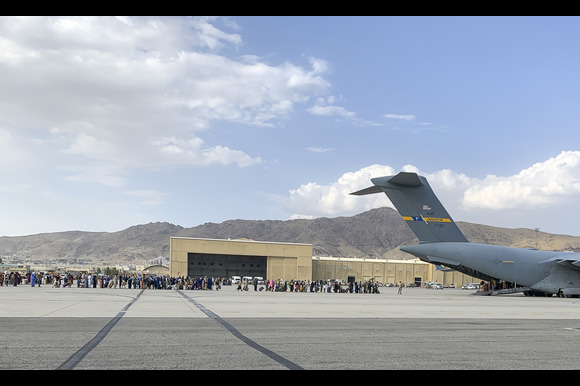
By U.S. Central Command Public Affairs
Four years after fleeing Afghanistan aboard a U.S. evacuation flight, Hanifa Girowal finds her thoughts returning to August 2021 every year.
A former human rights worker under the previous Afghan government, Girowal now lives in the United States, like thousands of others who were evacuated during the chaotic U.S. withdrawal. Yet, despite the years that have passed, she remains caught in what she describes as “legal limbo,” navigating a complex and shifting legal and political environment that has only grown more uncertain since U.S. President Donald Trump returned to office on January 20.
“I somehow feel like I’m still stuck in August 2021, and all the other Augusts in between—I can’t remember anything about them,” Girowal told Al Jazeera, recalling the trauma of those days: watching people gunned down in front of her, hiding for a week, and finally flying out to Qatar, then Germany, and ultimately to Virginia.
Trying to rebuild her life in the U.S. has meant confronting the past again and again. “Everything just comes up again to the surface, and it’s like reliving that trauma we went through—and have been trying to heal from—since that day,” she said.
Now, the anxiety has deepened. Trump’s hardline immigration agenda has cast a shadow over vulnerable immigrant communities, including the estimated 180,000 Afghans currently in the U.S.
“I have an approved asylum case, which gives a certain level of protection, but we still don’t know the future of certain policies on immigration,” Girowal said. “I am very much fearful that I can be subjected to deportation at any time. There is a feeling that anything could happen, from one day to the next.”
Legal Uncertainty and Mixed Immigration Pathways
Afghans arrived in the U.S. through a variety of legal routes following the Taliban’s August 15, 2021 takeover of Kabul. About 75,000 were airlifted during “Operation Allies Welcome,” launched under then-President Joe Biden. Others made perilous journeys to the U.S.-Mexico border to seek asylum, while some entered through Special Immigrant Visas (SIVs) or the State Department’s Priority 1 (P1) and Priority 2 (P2) refugee resettlement pathways, aimed at Afghans who worked with the U.S. government or American organisations.
According to Adam Bates, supervisory policy counsel at the International Refugee Assistance Project, certain pathways such as the SIV program lead to lawful permanent residency and eventually citizenship. But others, like humanitarian parole, offer only temporary relief, leaving evacuees in a vulnerable and uncertain legal position.
“A lot of the advocacy to the Biden administration officials was about finding more permanent legal pathways for Afghans,” Bates said. “That was with one eye toward the potential of giving the Trump administration this opportunity to really double down and target this community.”
Trump’s Immigration Actions Heighten Afghan Anxiety
Since taking office, the Trump administration has implemented a series of policies affecting Afghan evacuees—often in contradictory ways. It has ended Temporary Protected Status (TPS) for Afghans who were already in the U.S. at the time of the Taliban takeover, claiming an “improved security situation” in Afghanistan—an assertion disputed by multiple human rights organisations.
At the same time, Afghanistan was added to a revised travel ban list, restricting visa access under the rationale of “foreign policy, national security, and counterterrorism” concerns. Meanwhile, in a confusing shift, Trump has publicly criticised Biden’s handling of the evacuation and recently pledged to “save” Afghans stranded in the UAE who face deportation.
In April, the administration also ended special protections for Afghans who entered the U.S. via the CBP One app, a move likely to affect thousands of individuals who crossed at the southern border.
Another looming crisis is the expiration of humanitarian parole for tens of thousands of Afghan evacuees. Initially granted for two years, this status was extended once in 2023 but is soon set to expire. While many evacuees have since applied for asylum or SIVs, the number who remain on humanitarian parole and could become undocumented remains unclear. USCIS has not publicly disclosed the figures and did not respond to Al Jazeera’s request for data.
Bates warns that Trump’s policies, coupled with increasing immigration enforcement even against non-criminal immigrants and activists, has left the Afghan community gripped by fear.
“It’s just an escalation across the board and a compounding of fear and instability in this community,” he said. “It’s hard to make life decisions if you aren’t sure what’s going to happen tomorrow or next week or in a year.”
Doors Closing for Afghans Abroad
The path to safety is narrowing for Afghans still abroad. Trump has paused asylum processing at the southern border, citing a national emergency, and has all but suspended the U.S. Refugee Admissions Program (USRAP). New refugee arrivals are trickling in, and ongoing litigation from rights groups continues to challenge the administration’s actions.
The P1 and P2 programs—established by the Biden administration to help at-risk Afghans—also appear to have been quietly halted under Trump, with no public updates or admission numbers released since he took office.
Kristyn Peck, CEO of Lutheran Social Services of the National Capital Area, said the changes are devastating. “It feels as if we have pulled the rug out from many of our Afghan allies through these policy changes that strip legal protection for many Afghans in the U.S. and limit pathways for Afghans who are still abroad to come to the U.S. safely,” she said.
Peck noted that while the SIV program continues to operate, new restrictions require approved applicants to fund their own relocation. Meanwhile, resettlement agencies like hers have had to drastically reduce operations following a stop-work order from the administration in January. As of March, Lutheran Social Services had laid off about 120 staff members.
A Fragile Support System
Susan Antolin, executive director of Women for Afghan Women, a nonprofit offering legal, social, and mental health services to Afghans in the U.S., said organisations like hers are bracing for further instability.
“We are diversifying our funding and trying very hard, as so many other organisations are, to find other avenues to bring in that funding to continue to support our programmes,” Antolin told Al Jazeera. “As organisations that deal with this kind of work, we have to step up. We have to do 10 times more—or 100 times more—of the work.”
The World Moves On
The deteriorating legal situation in the U.S. is part of a broader global trend. Despite ongoing human rights abuses, the Taliban has strengthened diplomatic ties with multiple countries. In July, Russia became the first nation to officially recognise the Taliban as Afghanistan’s legitimate government.
Simultaneously, countries like Pakistan and Iran have accelerated deportations of Afghan nationals. According to the UNHCR, over 1.4 million Afghans left or were expelled from Iran between January and July 2025. The UAE, where many evacuees have been temporarily housed, has also begun deportations.
Germany, despite not recognising the Taliban regime, has resumed deportation flights. In July, it carried out its second deportation flight to Afghanistan since the Taliban takeover.
All of this sends a chilling message to Afghan evacuees, Girowal said: “We know that Afghanistan is no more a priority for the world.”
Yet, even as political will and legal protections erode, she holds on to a cautious hope. “I know the resilience of our own Afghan community,” she said. “We are trained to be resilient wherever we are and fight back as much as we can. That’s one thing that gives me hope.”




